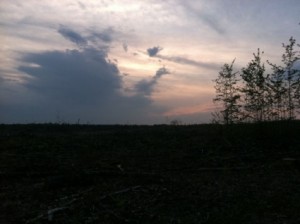
This area was once heavily forested. Photo © Laura Martone.
Like others who frequently travel across America, I’ve often been lucky enough to experience the same places more than once. Whenever I return to a specific town or region, it’s always comforting to find at least some of my beloved destinations still intact. After arriving in Chicago, for instance, I’m always eager to check out the exhibits at the Field Museum and the Art Institute, watch a Cubs game at Wrigley Field, and gobble down a slice of stuffed spinach pizza at Giordano’s. Likewise, during my annual visit to Los Angeles, I always try to make time for a stroll along the Santa Monica Pier, an afternoon picnic at the Los Angeles County Arboretum, and an evening of shopping and noshing at the Original Farmers Market.Sadly, though, my favorite haunts aren’t always where I left them. Restaurants, shops, galleries, and attractions can close at any time, whether due to economic downturns, owner whims, natural disasters, terrorist attacks, or other unfortunate situations. I’ve already chronicled some of these disappointments on this very blog—such as the now-closed Dolphin Cove Oyster Bar on South Padre Island, the Louisiana fishing camp that my dad owned prior to Hurricane Katrina’s destruction, the Pirate Soul Museum that recently relocated from Key West to St. Augustine, and Smedley’s Ice Cream Parlor, which is now a hotel in Silverton, Colorado.
Perhaps the most disappointing change, however, took place over this past winter in northern Michigan, my summertime home base. Surrounded by vast forests and inland lakes, this region is ideal for an outdoor enthusiast like me. Within walking distance of my house lies a vast 160-acre property that, for the past several years, served as one of my favorite hiking areas—that is, until the absentee owner decided to sell his vast, relatively untamed forestland to a lumber company, which proceeded to denude the landscape of all its stately birch, pine, and oak trees before putting it back on the market. Not only did this irresponsible company fail to plant new trees, it also left behind pothole-riddled logging roads and piles of pine needles, branches, stumps, and other debris, making it quite an eyesore, according to my brother-in-law, who had seen it during the winter.
So, imagine my horror when I returned in late May to find a silent wasteland (pictured above) in place of the lively, verdant woods that I’d left last October. Besides the devastation, it was dismaying to note the lack of animal activity. Where had all the birds, chipmunks, black squirrels, porcupines, and white-tailed deer gone?
Now, don’t misunderstand me. I’m certainly not opposed to logging. As someone who utilizes wooden furniture, cardboard boxes, and No. 2 pencils, I’d be a hypocrite if I were. But, still, commerce isn’t the only priority in such a situation—nor is it incompatible with responsible logging. I understand that the property owner wanted to sell the land. I also understand that, given the current state of America’s economy, it was difficult to find a buyer. The land, after all, had no utilities or lake access, making it undesirable for those hoping to build a house, while the sandy soil made it unfeasible for farming. With lumber prices on the rise, an eager lumber company was the most likely candidate, but why did the logging have to be done in such an irresponsible manner? Why couldn’t the company have replanted some of the trees—or, at the very least, cleaned up its mess?
Luckily, life has slowly returned to this neighboring wasteland. Ferns and other plants pepper the landscape, and while hiking or biking around the perimeter, I’ve noticed flitting robins, scurrying rodents, grazing deer, and other easily spooked creatures. Although it could be decades before the land again resembles the forest of old, it’s heartening to think that, in spite of rampant human greed, nature will indeed find a way to thrive. Still, I sure do miss that forest—and the wild blueberry patch at its core that the logging trucks saw fit to destroy.
So, during the course of your own travels, have you ever discovered that a favorite haunt no longer exists? If so, what happened to it—and what was left in its place?